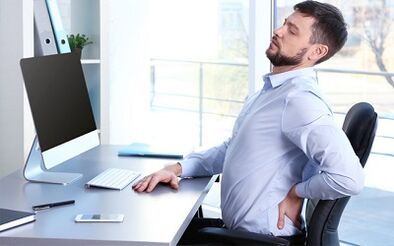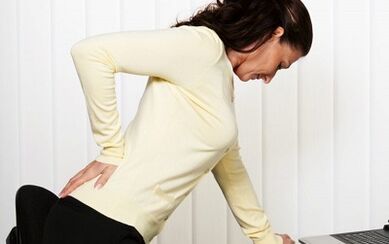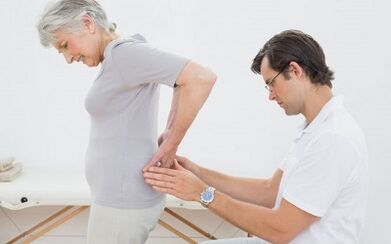
Acute pain in the lumbar region, in the background of osteocondrosis of the spine, is a widespread problem that is faced with the vast majority of people.If we get as a "reward" for our clarity (increasing the axial load of the spinal column), this disease will sooner or later affect all the planet's residence, the only question is how fast it happens and how it expressed the symptoms.Such "lean" statistics force this pathology into socially significant diseases, and not only a person suffering from the disease, but also the world's health system as a whole.Therefore, the issue of treating osteochondrosis of the spine is a very relevant topic.
So what is osteochondrosis?Briefly consider how the disease is developed.In its name, if you literally translate from Latin, the structures that change with osteochondrosis are determined: bone and cartilage.In order to devalue and resist the vertical loads, the nature between the vertebrae is placed in a specific fibrous-circuit in "pillows" intervertebral plates.Their nutrition is carried out in childhood because of the blood vessels, which are lost about 25 years and the nutrition begins diffuse due to the surrounding muscles.
In the pathological loads of the spinal column (sedentary work or vice versa - excessive physical activity), the intervertebral dials lose its elastic and depreciation of the processes of mineral metabolism, reduces its height, the structure of vertebrate changes, the growth of the pathological bones (osteophytes and the tissue).The affected area of the spine.At the late stage of the disease, the central part of the intervertebral disk, the so -called jacket, which breaks the fibrous ring, forms a kind of protrusion between the bodies of the vertebrae - the intervertebral hernia.The hernia can cause compression of the nerve roots adjacent to the vertebrae, and intense pain occurs in the compression zone and the area regulated by the nerve affected.Due to constant irritation of nervous plexus, skeletal muscles occur reflex cramps, called protective protection, which, on the one hand, protects the suffering of the spine from excessive movements and improves compression, edema and pain in the affected area.
In the vast majority of cases (90%), osteochondrosis (still extremely pronounced) pain is due to muscle cramps!In other cases, the cause of pain is the compression of the nerve root or spinal cord directly with the intervertebral disk.
Lumbar spine osteochondrosis: How to treat
From all parts of the spine and a total of five (cervix, chest, lumbar, sacred and coccygeal), due to the largest motor load, lumbar is most often suffered from manifestations of the disease.Osteochondrosis of the lumbar spine has bright symptoms for everyone, and its treatment is a significant social task, as it deteriorates not only the quality of life of the elderly, but also the active people of working age.
The pain is directly in the lumbar region, as well as on the front surface of the thigh, or on the entire back or outer surface of the foot, sometimes to the fingers.They often give pain to the gluteal region, the sacrum, the legs, and can sometimes be localized only in these areas that are disguised as a disease of the Gögingourinal sphere and intestines and make it difficult to make the correct diagnosis.The intensity of the pain syndrome can be so high that one loses their ability to perform the most important movements, takes on forced poses and loses normal sleep.This is exactly the same radical, which has long since become synonymous with the disease.

Limit motor activity.The habitual movements and sensitivity of the limbs are violated, muscle curves, paraesthesia (feelings of tingling, feelings of "climbing gobambs").
Violation of the function of pelvic organs.In the case of intense radicular syndrome, which can be disturbed by radical or huge hernial protrusion for everyone, it can cause severe agony in the patient.
Treatment of osteochondrosis of the lumbar spine often becomes difficult for both the patient and the doctor.Everyone who suffers from this disease and questions: "How to treat the lower back of the lower back?", "How to treat lumbar region osteochondrosis?", "If the lumbar class osteochondrosis treatment at home does not help?
The following doctors will help you cope with aggravation of osteochondrosis and prescribe the competent treatment: therapist, neurologist, medical massage -specialist, manual therapist, physiotherapist, and, if necessary, surgical treatment for neurosurgery.
Ways to overcome osteochondrosis of the lumbar spine
The most important thing for treating osteochondrosis is the right lifestyle!In people who are actively and correctly involved in physical culture and pay attention to the spine, the back is never harmed!Unfortunately, few people follow these simple truths.
By analyzing the problem you can highlight:
- medicine;
- No -Drog.
No -drog methods to treat lumbar spine pathology
- Disturbing procedures- Their effect lies in the name itself - the use of various applicators, massage carpets and rollers, wool belts, "creams" and "rubbing" due to the effects of surface nerve endings, and blood vessels slightly reduce muscle cramps and pain syndrome.These methods can be used as an accessory, but isolated use is ineffective if it is not effective without systemic systemic treatment.
- Immobilization tools- These tools are understood as various design bandages that allow the spine to be protected from sudden and "dangerous" movements and redistribute the load during static work.Immobilization tools can be purchased at medical equipment and pharmacy stores, but before buying it is advisable to consult a doctor who helps determine the optimal formation, stiffness and completion of the bonding in your position.We recommend that only exposure to harmful factors (wheel hike, sitting work and so on) as long -term use causes musclehypotrophy.
- Medical physical education (exercise therapy)- an integrated component of complex treatment of osteochondrosis.Maintaining the sound of the back muscles and removal of pathological muscle cramps promotes the restoration and reduction of motor activity and reduces the reduction of pain syndrome.Exercise therapy is a significant plus that after a training session, one person performs exercises daily at home, as well as the existence of exercises that can be used even by exacerbating the process.The most effective method of exercise therapy is the mechanotherapy of simulators - individually developed, as it has to work with weights to develop muscle linen.
- Massage- The most common and perhaps the most common method of prevention and treatment is known from ancient times, but it is nevertheless not used in the phase of lumbar osteochondrosis.In addition, only a medical education specialist who knows the anatomy and physiology of medical medical massage, as well as medical massage possession techniques, must perform a massage with osteochondrosis.
- Manual therapyAnd in recent years, in recent years, an osteopathy performed by a competent specialist can have a significant healing effect and, for a long time, eliminate the worsening of the disease.It is also important to note that when the procedures are to be treated, a handicraft (radiography, calculated or magnetic resonance imaging, osteodensitometry) should be tested to allow the physician to evaluate the prevalence and severity of the process and exclude possible resistance.Like massage, manual therapy and osteopathy have a number of contraindications, such as the compression of the nerve root of the hernia and the subluxation of the vertebrae.During the acute period of osteochondrosis of the lumbar region, soft therapy is usually used (muscle relaxation and so on).
- Acupuncture- According to the results of recent studies, the use of a widely popular methodological method is considered to be a drug based on evidence, which is unreasonable for osteochondrosis of the lumbar spine, which does not eliminate the symptoms of the disease and indicate non -conventional treatment methods.
- Physiotherapy, including national clinical recommendations and medical care for osteochondrosis, has long proven its effectiveness in treating this disease.Lumbar spine, electromiostimulation, amplipulse therapy, shock therapy, intracamous myostimuration, laser therapy are used.Magnetic treatment remains the popular method.Its benefits include a small list of good tolerance and contraindications, the possibility of use during the acute period of the disease.It affects all links to the pathological process, significantly reducing pain after several procedures and allows people to expand motor activity.In addition, it slows down the progression of the disease by improving the trophy of affected tissues.The unconditional advantage of this method is that the patient's independent use of the medical institution's out -of -wall use.
But if all of the above non -drog methods were not effective - how to treat lumbar osteochondrosis?
Drug treatment
Diseases include the appointment of the following medical groups.
Non -seertoid anti -inflammatory drugs (NSAIDs) are produced in the form of local (gels, ointments, cream) and systemic use (tablets, candles, intramuscular and intravenous dosage).Their operation is based on the blocking of the inflammatory process at the enzymatic level, which results in the elimination of edema in the lesion zone and the pain syndrome significantly reduces.
In the early stages of the disease, NSAIDs have sufficient local use in combination with non -Valley methods (therapeutic exercises, magnets).With outstanding pathological method and intense pain syndrome, you should consult tablet and sometimes injectable drugs.
Unfortunately, NSAIDs have a good anti-inflammatory and analgesic effect, with longer systemic use, the development and aggravation of the gastrointestinal-to-arosive processes, and the damaged kidney and liver function.Therefore, patients who take NSAIDs for a long time need drugs that protect the stomach mucosa and regular laboratory control of the liver and kidneys.
Systemic muscle lakes, ie drugs that alleviate muscle cramps.The principle of their actions lies in the title: relaxation of cramped muscles helps to reduce the compression of nerves and blood vessels, edema in the harmful zone - improves blood circulation and innervation - reduce pain;As a result of the reduction of muscle protection, the voltage of the league - the stabbing (protrusion) of the intervertebral disc decreases - the pain decreases and the volume of movements increases.
Musorelaxants for the treatment of osteochondrosis of the spine are produced in the form of tablets and solutions for intramuscular administration to achieve the therapeutic effect, which should be taken for a long time, gradually increasing the dose.Like NSAIDs, muscle lakes have many contraindications and can cause unwanted side effects, so despite free sale in pharmacy networks, you have to consult a doctor before buying it.

Local anesthesia or drugs for local anesthesia are used for drug treatment for lumbar osteochondrosis in the form of a paravebral blockade combined with SO, when the drug solution is first subcutaneous and then projected to the affected spinal cord process by projecting alleged compression of the nerve root.
When accumulating into the membranes of the nerve fibers, the drug effectively blocks the pain signal.The therapist will certainly not be able to execute such a blockade;You need to contact a neurologist or neurosurgeons for your behavior.
In addition, glycocorticosteroids (GKS) - hormonal drugs that have a particularly anti -inflammatory effect is used for paravebral administration.Their local application allows maximum effect to minimize the risk of unwanted side effects of the drug.Such a blockade is performed 2-3 times a year, and the neurologist or the neurosurgeon doctor must perform them.
Vitamins B "B".In any pharmacy you can find the various drugs of this group, both in the form of oral administration and for intramuscular administration.It is believed that they have neurotrophic and mild analogizing effects, but a reliable proof of osteochondrosis of the spine has not been obtained by evidence -based medicine.
Physiotherapy of lumbar osteochondrosis
Unfortunately, the use of modern drugs, physiotherapy, massage and exercise therapy is sometimes unaffected - people continue to experience pain, restrict physical activity, and quality of life suffers significantly.This happens in later stages of the disease, when it is voluminous, often multiple hernia for multiple vertebrae discs.In such a situation, surgical treatment is found.In addition, surgery is indicated by the so -called "hernia decomposition" when a significant compression of the spinal canal causes compensatory pain, statodynamic disorders and blocking the function of the bladder and intestine.In such cases, the operation is carried out in an emergency order.Surgery for osteochondrosis of the lumbar spine is aimed at mechanical decompression of the spinal canal and nerve roots.
Currently, both long known volume surgical methods are used in surgical treatment of osteochondrosis, and the minimum invasive endoscopic interventions recommended by modern medicine is recommended using laser and radio frequency effects, some of which can be performed even with local pain relief.
After examining the main methods of treating lumbar spine osteochondrosis, I would like to note once again that the patient asks the question: "How to cure lumbar osteochondrosis?"Not only do you have to rely on the help of doctors, but also your own forces, understanding the importance of a healthy lifestyle, in which we welcome the right dose and especially the physical activity, and most importantly, a branch is present.Victory over the disease.















































